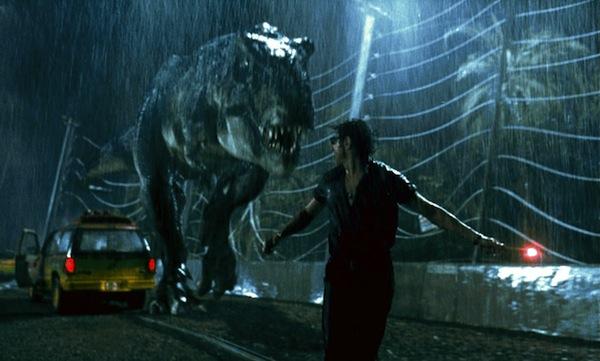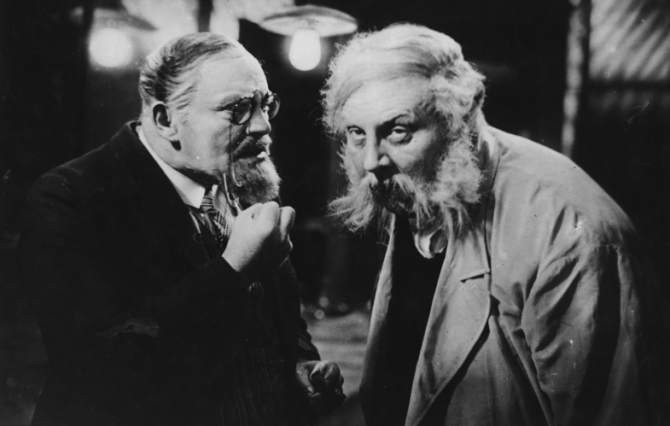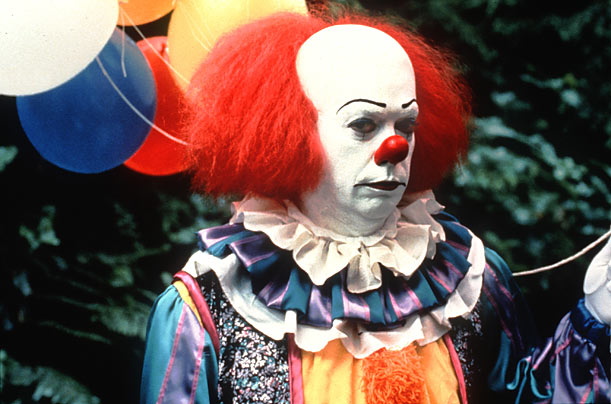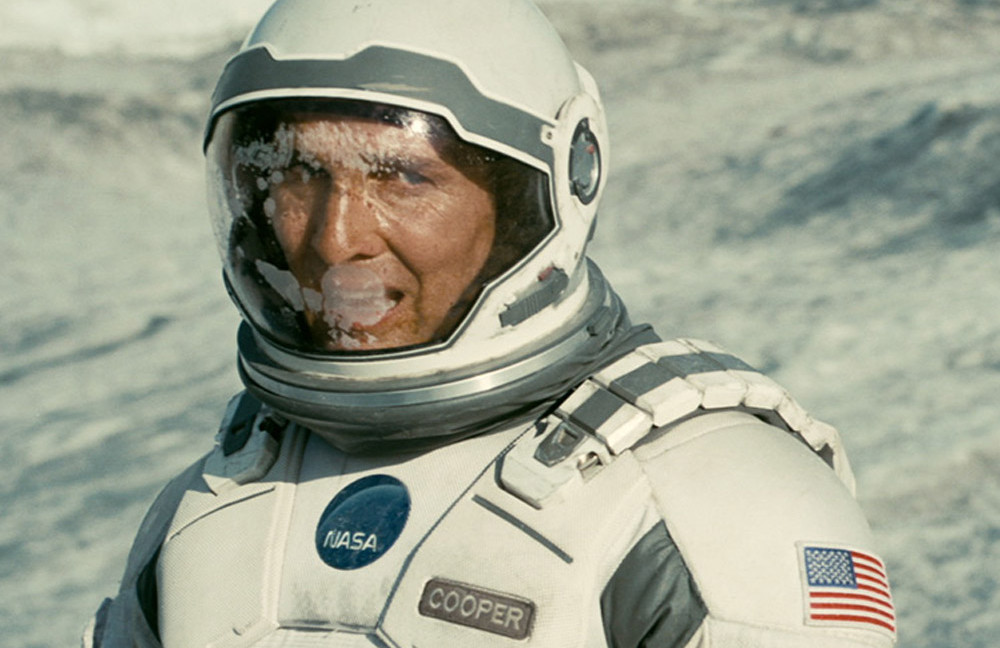6. Jurassic Park (1993, dir. Steven Spielberg)

For a popcorn movie, Jurassic Park has excellent atmosphere, and a playful sense of foreboding that accurately captures the incomparable size of the problem the characters face. But again the film wraps up with a big cliché.
A pair of palaeontologists (Sam Neill, Laura Dern) are recruited to assess a secret park at the request of the owner (Richard Attenborough). The park has bred living dinosaurs as the main attraction.
At first overwhelmed with wonder, the palaeontologists (along with a few other guests) explore the park. Meanwhile, a greedy employee, Ned (Wayne Knight), shuts down the security during a storm in order to sell the DNA to a competitor. Ned is killed in his escape, and the dinosaurs attack the people stranded at the park by the storm.
The film immediately tries to make one distinction clear. Tyrannosaurus is the biggest, most impressive killer, but is relatively easy to deceive because of its poor vision. The truly fearsome creature at the park is the much smaller velociraptor, which has superior reasoning capabilities. The conflict with T-Rex occurs near the beginning of the film and she is thwarted easily.
The real showdown doesn’t occur until seconds from the ending. What had been a surprising chess match between the intelligent dinosaurs and the humans (who have a tendency tounderestimate the raptors), culminates in an out-and-out fight.
The humans have no more guns, doors, or vehicles to use. And even though they have foreknowledge of the raptor’s favourite attack, the knowledge isn’t much help without anything to defend themselves with. Clearly, the humans have been bested. Surprise! The T-Rex appears to save the humans.
This conclusion overrides any subtext to the film, and also implies that humans and raptors alike are too dumb to notice a forty foot, 6 tonne lizard stomping about. Even worse, it relies on the most overused of science fiction clichés: there’s always a bigger monster.
7. The Last Laugh (1924, dir. F. W. Murnau)

This film is one of the first examples of massive studio overreach, and a director who was able to outsmart his producers and his audiences simultaneously.
This glorious, technically innovative silent film follows a hotel doorman (Emil Jannings). He is a proud man who has provided for his family by welcoming wealthy guests into the glittering hotel he works for. The owner decides that the doorman is getting too old for the position, and demotes him to a cleaner in the hotel bathroom.
The doorman is crushed. He returns home and tries to hide the truth from his family, but he is discovered and his neighbours bully him. To escape their cruelty, the doorman takes to sleeping on the hotel bathroom floor. With his dignity completely stripped, the doorman has only the memory of his previous position to comfort him.
The original cut of the film ended here, or soon after. Murnau was a cinematic genius as we now know, but through the past ninety-five years of critical history, this film stands out as the earliest, most perfect example of cinema as an art form.
Up to this moment in time, title cards were used to explain the more complicated aspects of the plot, while the visuals were often a vehicle for action only. Murnau told this story without the use of any titles, and forged the gold standard of storytelling in film.
When his production house, the famous German studio UFA, saw the film, they demanded serious changes. It was too sad, and needed a happy ending to please audiences. So Murnau included one title card, exposing UFA for their demands:
Here the story should really end, for, in real life, the forlorn old man would havelittle to look forward to but death. The author took pity on him and has provided a quite improbable epilogue.
And so Murnau snidely decided to grant their wish — in the most blatantly Dickensian, over the top, offensively happy ending he could come up with. He purposefully ruined his film.
In the end, millionaire A. G. Money dies in the hotel in the doorman’s arms, and wills all of his money to him. The doorman is depicted in the hotel at a lavish banquet, wealthy beyond reckoning, well dressed and beaming. In the end, he leaves the hotel and tips his replacement!
Audiences adored it. Critics praised it, and the earnings from the film impressed the studio executives so much that Murnau was given his own fortune to direct movies with. Sometimes, ruined films are the greatest successes.
8. It (1990, dir. Tommy Lee Wallace)

A film damaged by its quest to pack too much novel into not enough hours.
A legendary villain portrayed perfectly by Tim Curry is investigated by a group of school children in 1960. Able to take the form of the thing its prey most fears, this creature is a fearsome enemy.
The kids, all with deep psychological scars from their pasts, find strength in numbers. Their leader, Bill (Jonathan Brandis) is awakened to It’s existence when his little brother has his arm ripped off by something living in a storm drain. The friends are terrorized by It in its various forms, and they have to hide evidence of the thing not only from their parents but also the local bully, Henry (Jarred Blancard).
The more the team investigates, they realize that It has been around for centuries, surfacing every few decades to search for children to terrorize and eat. Eventually they formulate a plan that since It takes on many forms, It may also take on the weakness of the form it takes. They decide to confront the creature, and ultimately succeed in driving it back underground.
Henry is driven mad by the creature, and is taken to a mental asylum. In the second part of the film, the gang is reunited in the present day, where they are now adults. It has resurfaced again, and has begun to search for children. With spouses to protect and weakened imaginations, the friends are helpless at first but ultimately rise to confront It once again.
In the novel of the same name by Stephen King, it is discovered that the only way to defeat the creature is through an ancient battle of wills. Bill must overcome all of his fears, both created by It and every insecurity he has to metaphorically bite the tongue of the creature, and withstand having his own tongue bitten. By doing this, he weakens the creature long enough for the rest of the team to attack.
In the end of the film, It is lamely killed by a slingshot wielded by an adult, even though it was already established in the first part that this tactic would not succeed. To make the ending even worse, the film closes with It’s evil laugh, implying that the group failed yet again.
9. Lolita (1962, dir. Stanley Kubrick)

Director Stanley Kubrick stated that he was not aware of how strict the censorship of this film would be, and even criticized his own depiction of Humbert (James Mason) and his forbidden infatuation with the title character.
Lolita opens in a dilapidated mansion, where Humbert kills a foolish drunk by shooting him. The film then backtracks four years. Humbert, a middle-aged professor, takes up lodging in the home of a single mother Charlotte (Shelley Winters) and her teenaged daughter Lolita (Sue Lyon).
A love triangle ensues when Charlotte falls in love with Humbert, and Humbert for Lolita. He agrees to marry Charlotte in order to be closer to Lolita, but when she discovers Humbert’s true desires, Charlotte runs madly out into the street and is killed by a motorist. Humbert takes this opportunity to collect Lolita, and they begin travelling across the country. Lolita, perhaps cognizant of the fact that Humbert is her only support, allows him to entrap her in a sexual relationship.
Some months after, Humbert is confronted by a psychologist (Peter Sellers) claiming to be from Lolita’s school, demanding to know how Lolita knows so much about the ‘facts of life’. Humbert runs, taking Lolita with him. When she becomes sick, he delivers her to a hospital. She disappears. Humbert is left with no clue where she is, until some years letter when she writes to him for money.
By this time she is married and pregnant. Humbert presses Lolita for the truth, and she confesses that the person who ‘kidnapped’ her was Clare Quilty (also Sellers), an old flame of her mother’s. Lolita admits that she developed a childhood crush on Quilty before Humbert had ever met her. She implies that she seduced Quilty into taking her away. After a few weeks she ran away from him, too.
The Kubrick ending was softened to suit censors, but it stays very true to the novel. Ultimately, it collapsed because of a single support beam that was not present throughout the rest of the film. In order to protect audiences from the notion that Humbert was a pedophile, the twelve year old Lolita of the novel became an older teen, and made to dress and behave as if she was older. She is portrayed as a womanly, beautiful female, wearing lipstick and heels.
The result was not that viewers were spared from the notion of pedophilia, but that they become complicit in it. The male gaze surrounds her as she reclines in her bikini, or as she slips off her high heels. She is sexualized as if she was an adult, and it in fact legitimizes Humbert’s attraction to Lolita.
At the climax, when Lolita reveals to him that she didn’t love Humbert, but in fact loved Quilty and entered willingly into a relationship with him, Humbert dissolves into tears and begs Lolita to run away with him. In the novel, Humbert is plain about his desires for prepubescent girls, Lolita in particular. But when he reunites with her again when she is a bespectacled, pregnant adult, he is shattered. It is at this point that he declares his love for her, despite his established attraction only to children.
When she refuses, he gives her all the money he has and leaves her alone. By contrast, since Kubrick’s Lolita was portrayed as a sexy, flirtatious adult that just happened to be born a little too early, Humbert’s collapse seems merely whiny. His complete destruction is not believable, and, at that most important moment when he tells her he loves her in spite of everything, he means he loves her even though she (rightly) ran away from him. The revelation is unmoving.
Kubrick, perhaps to save us from further agonies, ends quickly. Humbert leaves the house, and a few shots from the beginning of the film are inserted. We are reminded that the drunk man he shot at the beginning was really Clare Quilty, and a title slate informs us that Humbert died in prison for killing him.
In short, Lolita as a story is difficult to open up to, and it must be treated with extreme care. But that care must not be invested in masking the rape of a minor. These are imperative parts of the story.
If it is to be told for the big screen, the care must be given to showing Humbert as a human, as morally despicable and evil as he is. Otherwise the ending is merely one fool executing another for a woman who doesn’t care.
10. Interstellar (2014, dir. Christopher Nolan)

There are some films that obtain widespread acclaim despite their poor endings.
In Interstellar, a widowed former pilot, Matthew McConaughey’s Joseph Cooper, has moved on to a farmer’s life with his daughter Murphy (MacKenzie Foy). Set in the future, the earth is undergoing a severe crop blight that will eventually starve humanity.
One day, Murphy sees strange activity in her room, and eventually coordinates are discovered in the dust on the floor of this room. They decide to investigate the coordinates and come upon a hidden NASA base, where Cooper is asked to fly a mission through a wormhole to help humanity find a new planet to colonize. Cooper eventually agrees.
On the mission, Cooper and his crew go through the wormhole and find several planets there. The crew decides to investigate the planet with reports of water on it, even though the time on the planet passes much more slowly than on earth. Waves kill part of the crew and damage the ship, delaying the operation for a few hours, but is equivalent to more than twenty earth years.
Meanwhile Murphy, now an adult, is trying to solve mathematical equations that would allow for humans to leave earth and settle on a new planet. Otherwise, she discovers, humanity will have to live on through frozen embryos only, and all life on earth will die. The second planet Cooper’s team investigates is uninhabitable also, and the astronaut (Matt Damon) in charge of collecting data there tricks Cooper’s crew into rescuing him. He steals the ship but succeeds only in damaging it and killing himself.
Cooper and his remaining crew member (Anne Hathway) stabilize the ship, but a black hole is pulling them in. Cooper decides to jettison himself to help propel the shuttle and the remains of his crew to the third planet and try one more time to find a habitable place. Cooper himself is resigned to his fate and is pulled into the black hole.
In the end, Cooper goes into the blackhole, ignoring all theoretical physics. He finds that, somehow, within the event horizon is a module capable of seeing into Murphy’s book case in the past, where Cooper can then give himself the coordinates to the NASA research facility, set his own story in motion, give Murphy the math she needs to save humanity, and instantly solve all of his, and humanity’s, problems. Then he is magically rescued, and winds up in the new human colony Murphy designed, and everything is perfect.
There’s deus ex machina, and then there’s Joseph Cooper. He is a whole new frontier of unlikely.
Author Bio: Erika Livingstone graduated with a BA from the University of Calgary, where she was a founding member of the U of C film criticism collective, and of their journal, “Crash Cut”. She works for the Calgary International Film Festival in the short film selection program. She has an unhealthy obsession with gothic art, and spicy food. You can follow her on Facebook or Twitter @LivingErika.